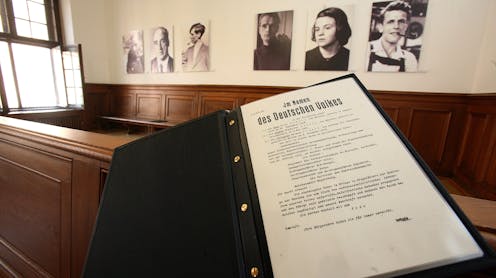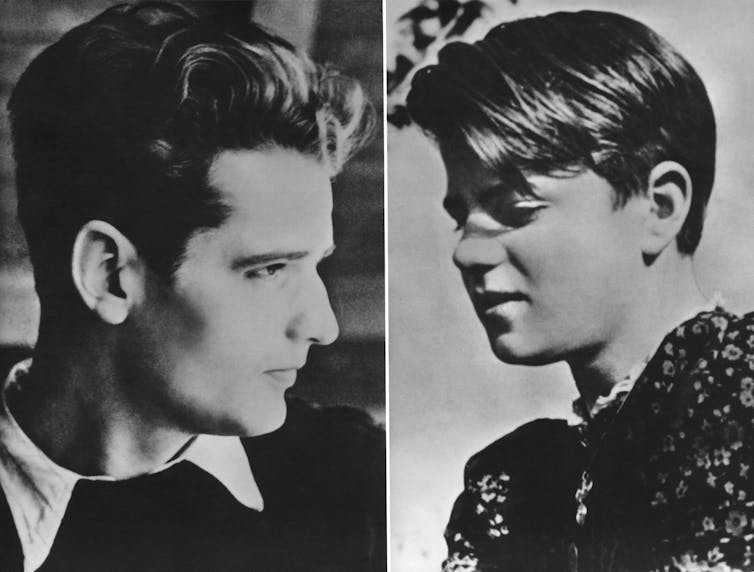How a reading group helped young German students defy the Nazis and find their faith
- The White Rose movement, formed by German students and professors in Munich and Hamburg from 1942 to 1943, defied Nazi tyranny through their faith, friendship, and humanistic learning.
- The group’s resistance was rooted in a Catholic intellectual tradition, which they encountered through the works of theologians like Augustine, Georges Bernanos, and Jacques Maritain, and helped them cultivate an interior life grounded in prayer.
- The White Rose movement’s personal writings reflect a religious passion, with members like Sophie Scholl stating that “better to suffer intolerable pain than to vegetate insensibly” and finding strength in their faith during imprisonment.
- John Henry Newman’s philosophy on the primacy of conscience resonated with the group, emphasizing the importance of learning, conversations, and experiences in shaping one’s moral compass.
- Today’s students aspire to act with clarity and conviction, seeking an intellectual tradition that helps them discover their vocation and live with integrity, similar to the White Rose movement’s commitment to truth-seeking and challenges.

For three weeks in April 2025, my “Theology of Christian Martyrdom” class studied how a group of German students and professors from Munich and Hamburg formed a resistance movement from 1942 to 1943 known as the “White Rose.” These individuals defied Nazi tyranny, they were imprisoned, and many were executed.
At the movement’s center were Hans Scholl, Sophie Scholl, Alexander Schmorell, Christoph Probst and Willi Graf, who were all in their 20s, and Professor Kurt Huber. The Scholl siblings, their friends and their professor were beheaded for urging students at the University of Munich to oppose the Nazi regime.
On the surface, the White Rose’s “crime” was the writings, printings and distribution of six anti-Nazi pamphlets urging Germans to resist Adolf Hitler and work to end World War II. However, a closer examination of their pamphlets, along with excerpts from their diaries and letters, reveals that their resistance was rooted in something deeper – a faith anchored in friendship and a humanistic learning. Their time together reading and discussing theological texts deepened their Christian faith.
Teaching this class taught me that teachers can inspire students to improve their country’s social and political landscape through the study of literature, history and theology. Teachers can help students form their consciences and empower them to act against falsehood and injustice.
The White Rose movement
These young people came from a variety of Christian backgrounds, including Catholic, Lutheran and Orthodox traditions. Some had been members of the Hitler Youth as teenagers, while others had served as medical assistants in the German army. They formed strong bonds and underwent personal transformations as students at the University of Munich, where they were mentored by a couple of philosophers, especially Kurt Huber, who was a devout Catholic.
The students met regularly and secretly with their professors to study literature, philosophy and theology from the Catholic intellectual tradition, banned by the Nazi regime as part of Hitler’s strategy to first stifle and then strangle the Catholic Church in Germany. Based on the students’ correspondence and diaries, their covert engagement with Catholic thought became a cornerstone of the White Rose’s rejection of Nazi tyranny.
In the works of the fifth-century North African theologian Augustine, the 20th-century novelist and playwright Georges Bernanos, and the 20th-century philosopher Jacques Maritain, these students encountered a Catholic intellectual tradition that was responsive to the urgent questions of their time.
From Augustine they learned the importance of cultivating an interior life grounded in prayer. Bernanos stressed the importance of embracing one’s humanity to confront evil. Maritain emphasized the need to strive for a free democratic society.
Importance of prayer
The White Rose movement was concerned not only with the present state of humanity but also with its future, and not only with the individual but also with the communal. In their clandestine meetings and correspondence, they wrestled with the relationship between faith and reason, goodness in the face of evil, the meaning of tyranny, the nature of a just state, and the foundations of genuine liberty. Addressing these serious issues not only matured their intellects but also deepened their hearts; it taught them the importance of prayer.

Authenticated News/Archive Photos/Getty Image
“Better to suffer intolerable pain than to vegetate insensibly. Better to be parched with thirst, better to pray for pain, pain, and more pain, than to feel empty, and to feel so without truly feeling at all. That I mean to resist,” Sophie wrote in her diary in the early summer of 1942.
The personal writings of the White Rose reflect a religious passion, akin to the prayers of saints.
For example, in his imprisonment, Graf stated: “I know my Redeemer liveth. This faith alone strengthens and sustains me.” The impact of Christianity on the inner lives of these young people is a crucial part of their narrative and resistance.
Their circle of friendship became a haven in a totalitarian state that sought to isolate individuals, instill fear and transform these estranged and fearful people into part of a mass society. “We negated the many, and built on the few, and believed ourselves strong,” Traute Lafrenz, the last surviving member of the White Rose and a member of the Hamburg circle, later stated.
The most significant intellectual influence on the group may have been John Henry Newman, a 19th-century Catholic convert and theologian who emphasized the primacy of a “well-formed” conscience. His writings helped them recognize what Catholics like myself see as a moral truth that transcended Nazi propaganda – that each person bears within them the voice of the living God. This voice could not be silenced by state power.
Newman’s philosophy
Newman insisted that conscience is not merely intuitive but is shaped through learning – from conversations, books and lived experience. With their professors’ guidance, the White Rose students were able to cultivate their conscience.
If Newman were addressing college students today, I like to believe he would emphasize the significance of their conversations with friends on campus, the discussions held with classmates and professors in the classroom, the newspapers they read, the retreats they participated in, the novels they savored during the holidays, their road trips across the country, and their studies abroad. All of these experiences contribute to shaping their conscience.
Newman’s defense of broad, active and serious learning offered an appealing counterpoint to Nazi ideology, which sought not only to deprive individuals of their civil rights but also to crush their inner lives and capacity to form meaningful relationships through terror and fear.
The power of a well-formed conscience is perhaps best illustrated by Sophie Scholl, who shared Newman’s sermons with her boyfriend, Fritz Hartnagel, a Wehrmacht officer who fought for Germany during World War II.
In the summer of 1942, horrified by the brutality he witnessed, Hartnagel wrote to Scholl that Newman’s words were like “drops of precious wine.” In another letter, he wrote: “But we know by whom we are created, and that we stand in a relationship of moral obligation to our Creator. Conscience gives us the capacity to distinguish between good and evil.” After the war, Hartnagel became active in the peace movement and supported conscientious objectors. To the members of the White Rose, conscience was a spiritual stronghold – one the state could not breach.
Truth-seeking and challenges today
I believe that while my students today face different challenges – a society shaped by what I regard as the nihilistic presence of technological power and populism, rather than full-blown totalitarianism – they also aspire to act with clarity and conviction. Newman’s view on the formation of conscience resonated with my students as well.
What my students share with those young dissidents from over 80 years ago is a commitment to cultivating an inner life, fostering a community of friends and engaging in a vibrant intellectual tradition.
They are drawn to the writings that animated Hans Scholl, who, drawing inspiration from the Catholic playwright Paul Claudel, wrote the following just two days before his arrest.
“Chasms yawn and darkest night envelops my questing heart, but I press on regardless. As Claudel so splendidly puts it: Life is one great adventure into the light.”
As a teacher, I believe that young people want to engage with an intellectual tradition that helps them discover their vocation and live with integrity, similar to Scholl.
They seek to act with a clear conscience amid the uncertainties of their own times. This approach serves as a powerful contrast to any hollow, anti-intellectual and culturally bankrupt tyranny.
![]()
Peter Nguyen, SJ does not work for, consult, own shares in or receive funding from any company or organization that would benefit from this article, and has disclosed no relevant affiliations beyond their academic appointment.
